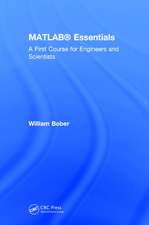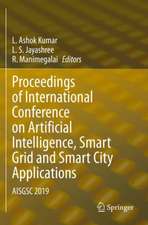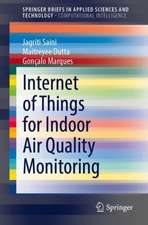Numerical and Analytical Methods with MATLAB for Electrical Engineers: Applied and Computational Mechanics
Autor William Bober, Andrew Stevensen Limba Engleză Hardback – 27 aug 2012
This book includes:
- An introduction to the MATLAB programming environment
- Mathematical techniques for matrix algebra, root finding, integration, and differential equations
- More advanced topics, including transform methods, signal processing, curve fitting, and optimization
- An introduction to the MATLAB graphical design environment, Simulink
Din seria Applied and Computational Mechanics
- 9%
 Preț: 911.86 lei
Preț: 911.86 lei -
 Preț: 370.62 lei
Preț: 370.62 lei - 29%
 Preț: 961.40 lei
Preț: 961.40 lei - 26%
 Preț: 875.97 lei
Preț: 875.97 lei - 30%
 Preț: 780.53 lei
Preț: 780.53 lei - 28%
 Preț: 1065.94 lei
Preț: 1065.94 lei - 29%
 Preț: 1032.68 lei
Preț: 1032.68 lei - 18%
 Preț: 855.24 lei
Preț: 855.24 lei - 18%
 Preț: 907.47 lei
Preț: 907.47 lei - 18%
 Preț: 782.44 lei
Preț: 782.44 lei - 20%
 Preț: 1074.48 lei
Preț: 1074.48 lei - 15%
 Preț: 702.46 lei
Preț: 702.46 lei - 18%
 Preț: 1404.67 lei
Preț: 1404.67 lei - 20%
 Preț: 829.94 lei
Preț: 829.94 lei - 18%
 Preț: 1334.28 lei
Preț: 1334.28 lei - 18%
 Preț: 1260.78 lei
Preț: 1260.78 lei - 29%
 Preț: 1181.74 lei
Preț: 1181.74 lei - 28%
 Preț: 993.44 lei
Preț: 993.44 lei - 31%
 Preț: 690.52 lei
Preț: 690.52 lei
Preț: 1009.60 lei
Preț vechi: 1231.21 lei
-18% Nou
Puncte Express: 1514
Preț estimativ în valută:
193.20€ • 203.15$ • 159.63£
193.20€ • 203.15$ • 159.63£
Carte tipărită la comandă
Livrare economică 17 aprilie-01 mai
Preluare comenzi: 021 569.72.76
Specificații
ISBN-13: 9781439854297
ISBN-10: 1439854297
Pagini: 388
Ilustrații: 235 b/w images
Dimensiuni: 156 x 234 x 22 mm
Greutate: 0.72 kg
Ediția:New.
Editura: CRC Press
Colecția CRC Press
Seria Applied and Computational Mechanics
ISBN-10: 1439854297
Pagini: 388
Ilustrații: 235 b/w images
Dimensiuni: 156 x 234 x 22 mm
Greutate: 0.72 kg
Ediția:New.
Editura: CRC Press
Colecția CRC Press
Seria Applied and Computational Mechanics
Cuprins
Numerical Methods for Electrical Engineers. MATLAB® Fundamentals. Matrices. Roots of Algebraic and Transcendental Equations. Numerical Integration. Numerical Integration of Ordinary Differential Equations. Laplace Transforms. Fourier Transforms and Signal Processing. Curve Fitting. Optimization. Simulink. Appendices. MATLAB® Function Index.
Recenzii
"… I like the organization of the book and especially the early focus on matrix fundamentals … use of examples is excellent. …The end-of chapter problems are good … presents some excellent frameworks for computational methods— students should be able to build their programs more effectively by understanding the core components and following the directions…"
—Michael R. Gustafson II, Duke University, Durham, North Carolina, USA
"… covers MATLAB® first while providing gradual introduction first and progressing to advanced concepts. Numerical methods, algorithms, and implementations are well explained."
— Gleb V. Tcheslavski, Lamar University, Beaumont, Texas, USA
—Michael R. Gustafson II, Duke University, Durham, North Carolina, USA
"… covers MATLAB® first while providing gradual introduction first and progressing to advanced concepts. Numerical methods, algorithms, and implementations are well explained."
— Gleb V. Tcheslavski, Lamar University, Beaumont, Texas, USA
Notă biografică
Dr. William Bober received his B.S. degree in civil engineering from the City College of New York (CCNY), his M.S. degree in engineering science from Pratt Institute, and his Ph.D. degree in engineering science and aerospace engineering from Purdue University. At Purdue University, he was on a Ford Foundation Fellowship; he was assigned to teach one engineering course each semester. After receiving his Ph.D., he went to work as an associate engineering physicist in the Applied Mechanics Department at Cornell Aeronautical Laboratory in Buffalo, New York. After leaving Cornell Labs, he was employed as an associate professor in the Department of Mechanical Engineering at the Rochester Institute of Technology (RIT) for the following twelve years. After leaving RIT, he obtained employment at Florida Atlantic University (FAU) in the Department of Mechanical Engineering. More recently, he transferred to the Department of Civil Engineering at FAU.
Dr. Andrew Stevens, P.E., received his bachelor’s degree from Massachusetts Institute of Technology, his master’s degree from the University of Pennsylvania, and his doctorate from Columbia University, all in electrical engineering. He did his Ph.D. thesis work at IBM Research in the area of integrated circuit design for high-speed optical networks. While at Columbia, he lectured a course in the core undergraduate curriculum and won the IEEE Solid-State Circuits Fellowship. He has held R&D positions at AT&T Bell Laboratories in the development of T-carrier multiplexer systems and at Argonne National Laboratory in the design of radiation-hardened integrated circuits for colliding beam detectors. Since 2001, he has been president of Electrical Science, an engineering consulting firm specializing in electrical hardware and software.
Dr. Andrew Stevens, P.E., received his bachelor’s degree from Massachusetts Institute of Technology, his master’s degree from the University of Pennsylvania, and his doctorate from Columbia University, all in electrical engineering. He did his Ph.D. thesis work at IBM Research in the area of integrated circuit design for high-speed optical networks. While at Columbia, he lectured a course in the core undergraduate curriculum and won the IEEE Solid-State Circuits Fellowship. He has held R&D positions at AT&T Bell Laboratories in the development of T-carrier multiplexer systems and at Argonne National Laboratory in the design of radiation-hardened integrated circuits for colliding beam detectors. Since 2001, he has been president of Electrical Science, an engineering consulting firm specializing in electrical hardware and software.
Descriere
This textbook presents basic programming techniques consistent with the MATLAB software package. It also discusses numerical and analytical concepts applicable to electrical engineering. The text contains many sample MATLAB programs that provide guidance for student completing the assigned projects. Case studies relate concepts presented in the chapters to engineering in practice. The chapters address such topics as Simulink, curve fitting, optimization, partial differential equations, laplace transforms, control systems, signal processing, differential equations, transcendental equations, and numerical integration. A complete solutions manual is available for qualified adopters.
















